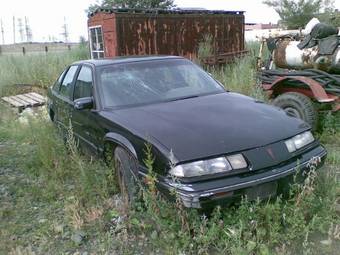1991 Pontiac Grand Prix
Photo #4 - Enlarge photo 640x480

Photo Information (Width: 340px, Height: 255px, Size: 19Kb)
Pontiac Grand Prix Problems
Replacing spark plugs
2001, I replaced the spark plugs and the wires,
but is still running rough, I am not sure if I...
Electrical warning light came on briefly then w...
2007, On the way home, heard signal bell and
message suggesting battery failure flashed then
q...
The Grand Prix is offered as a 2 door coupe or a 4 door sedan with 3 engine options; a 3.1-liter/160-hp V-6, a 3.8-liter/200-hp V-6, and a 3.8-liter/240-horse supercharged V-6. All come standard with a 4-speed automatic and ABS.
1991 Pontiac Grand Prix specs
|
Pontiac began selling cars with straight 6-cylinder engines with the 40 hp (30 kW) 186 ci (3.1 liter) (3.25x3.75 in, 82.5x95mm) L-head six in the Pontiac Chief of 1927; its stroke was the shortest in the American car industry at the time. The Chief sold 39,000 units within six months of its appearance at the 1926 New York Auto Salon, hitting 76,742 within twelve months. The next year, it becoming the top-selling six in the U.S., ranking seventh in overall sales. In 1933, it moved up to producing the cheapest cars with straight eight-cylinder (inline eight) engines. This was done by using many components from the 6-cylinder Chevrolet, such as the body. In the late 1930s, Pontiac used the so-called torpedo body of the Buick for one of its models just prior to its being used by Chevrolet as well. This body brought some attention to the marque. For an extended period of time, prewar through the early 1950s, the Pontiac was a quiet and solid car, but not especially powerful. With a flathead (side-valve) straight eight. These combinations proved attractive to the vehicle's target market - a reserved lower middle class not especially interested in performance or handling but seeking good value and a roomy vehicle in a step up from the entry-level Chevrolet. This fit well within parent GM's strategy of passing an increasingly prosperous customer up through the various divisions. Straight 8s are slightly less expensive to produce than the increasingly popular V8s, but they were also heavier and longer. Also, the long crankshaft suffered from excessive flex, which restricted straight 8s to relatively low compression and modest revs. In this application, inexpensive (but poor-breathing) flatheads were not a liability. » Read More About Pontiac |




